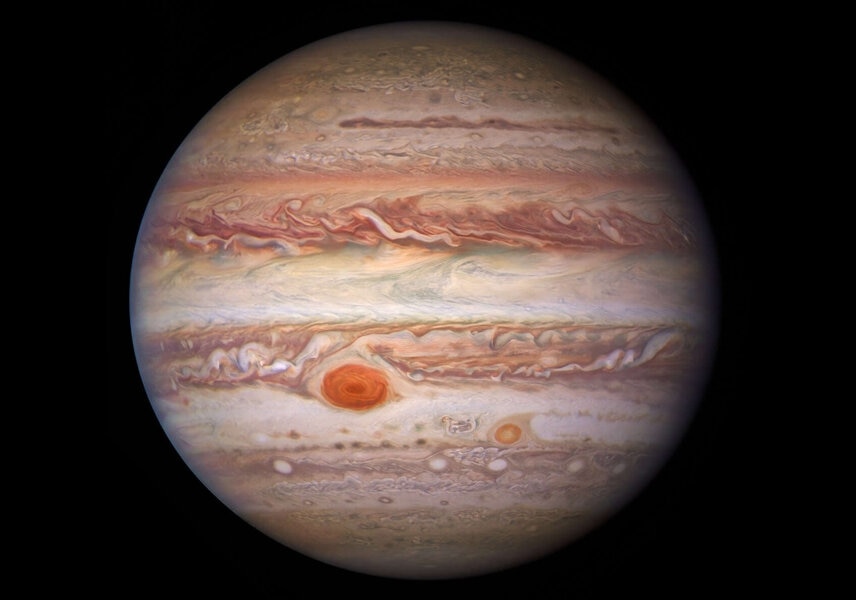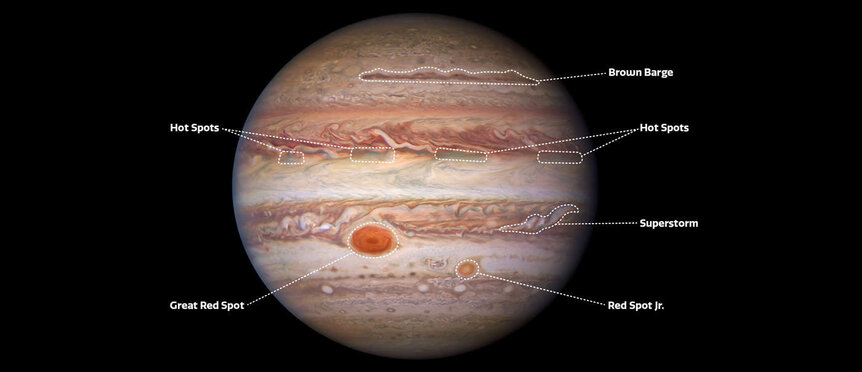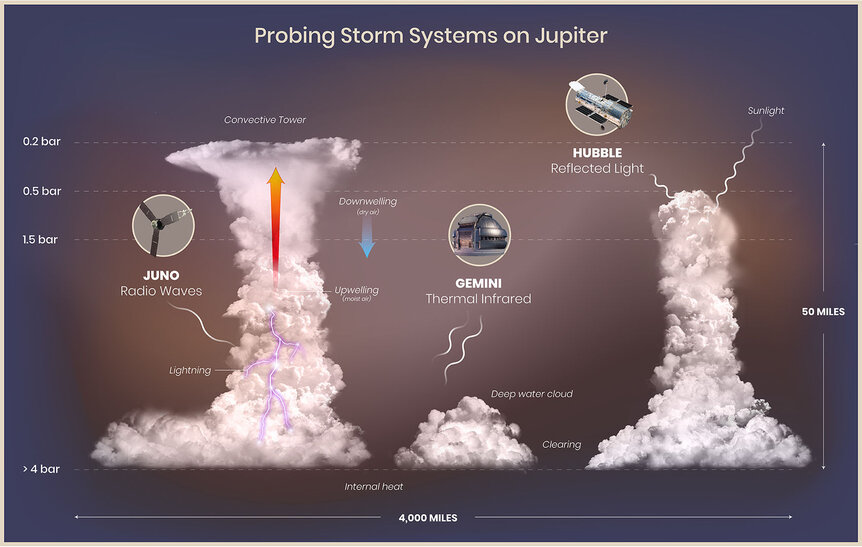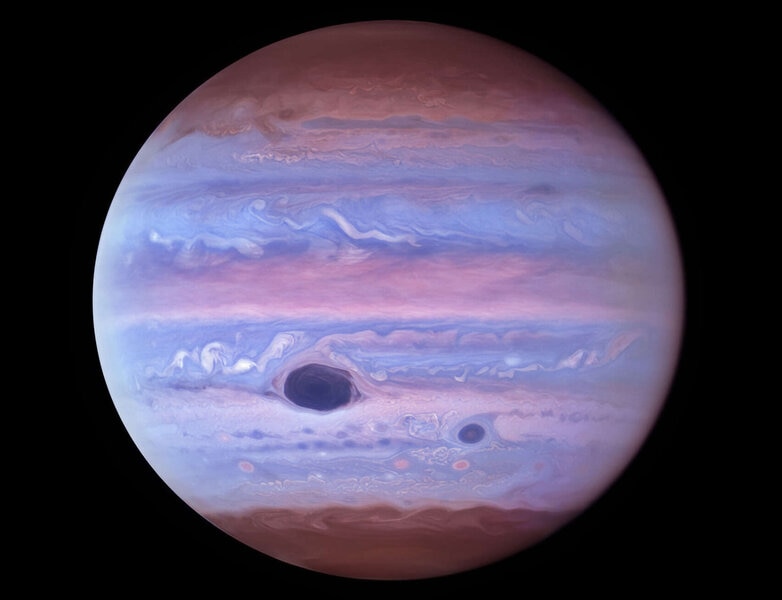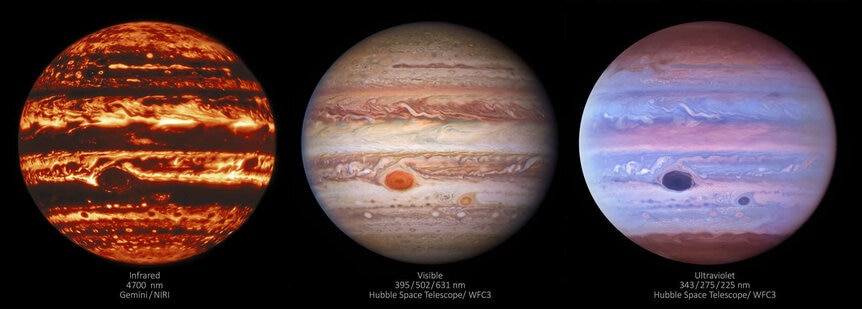Create a free profile to get unlimited access to exclusive videos, sweepstakes, and more!
New pix of Jupiter will rock your (very very large) world
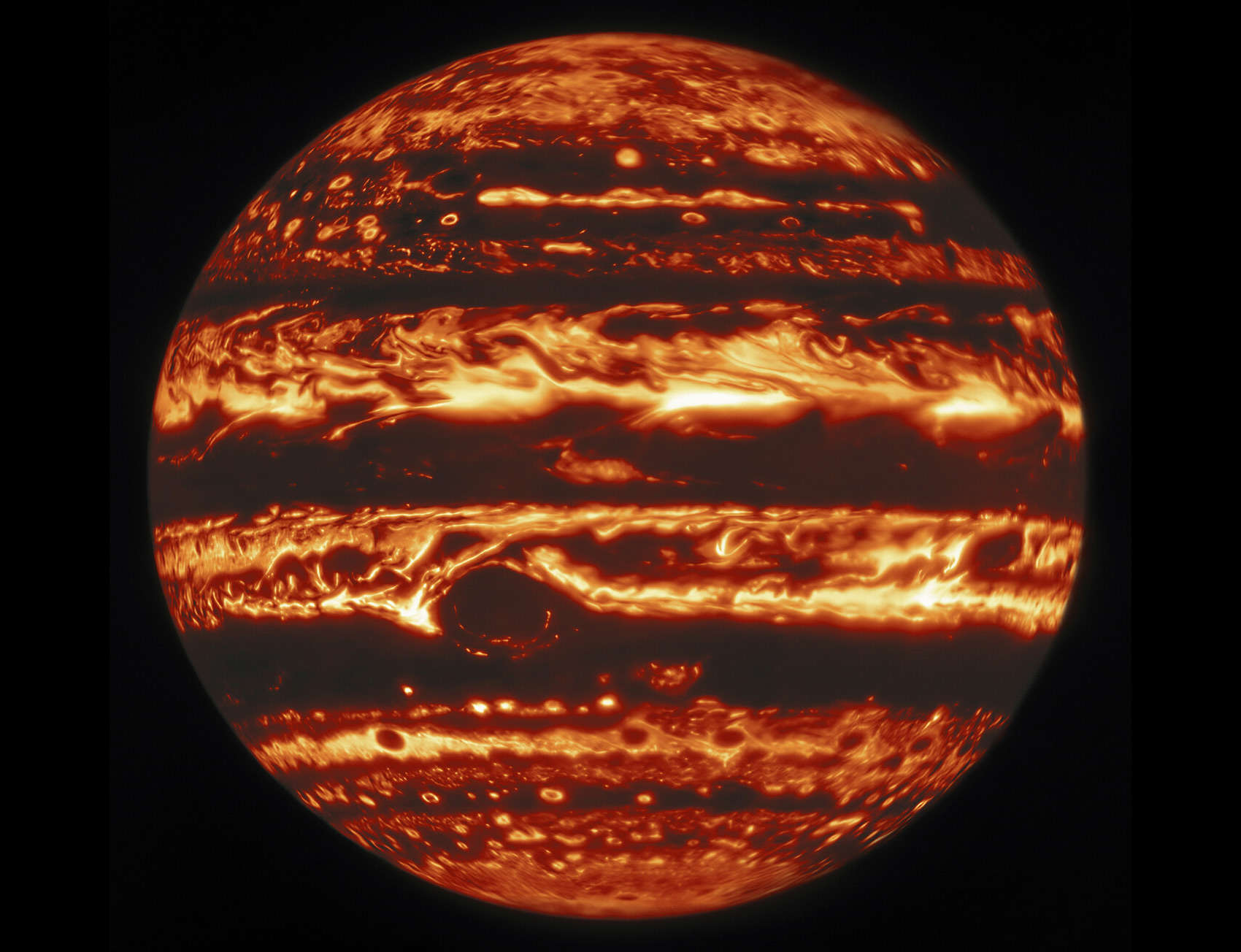
Jupiter never disappoints.
11 times wider, 300 times more massive, and 1,300 times the volume of Earth, it's truly enormous. It's bigger than some stars! So there's a vast amount of room on our solar system's biggest planet for interesting things to see.
On January 11, 2017, both the Gemini North Telescope in Hawai'i and the Hubble Space Telescope orbiting above Earth were pointed at this gigantic world, taking images nearly simultaneously in different wavelengths to probe Jupiter's atmosphere.
That's Jupiter in visible light, the kind we see, taken using Hubble's Wide Field Camera 3. The image mimics what we see in some ways, but isn't exact: It's a combination of three images taken using narrow-band filters that let through very specific colors of light (a narrow slice of red, green, and blue each), whereas our eyes see a much wider range of colors in those three wavelengths.
Still, you can see the familiar dark belts and bright zones, horizontal wind patterns in the cloud tops that form the broad stripes you can see even with a small telescope. But the detail! Ribbons and wavy turbulence mark the boundaries between stripes, and dozens of planet-sized circular storms can be seen all over the place.
The most obvious is the Great Red Spot, still going strong after centuries of existence. It's a high-pressure system, called an anti-cyclone, which has been shrinking a bit over the past few decades but is still easily big enough that you could drop Earth into it whole without touching the sides. Just to give you a sense of scale (and a frisson of existential dread).
To the lower right of the Great Red Spot is Oval BA (no relation to me), a storm that formed in 2000 when three separate storms merged. It appears red here but sometimes changes color; many storms do this including the Red Spot, which in the past has paled to a salmony pink. It's not well understood what molecules cause the red coloring in Jupiter's clouds, so scientists give them the generic name of chromophores ("color bearers").
That's all cool, but if you want to learn more about Jupiter you need to look at it in different wavelengths, like, say, infrared. And when you do, holy wow.
That is Jupiter in infrared (or IR) at a wavelength of about 4.7 microns, well outside what our eyes can see. This wavelength is good for seeing temperature differences in objects, which is why it's called thermal infrared. Here, warmer things are brighter and cooler darker. Usually warmer spots are because the air is clearer there, and we can see deeper into Jupiter's atmosphere where it's hotter. Clouds block that view, so in this shot bright = clear air, dark = cloudy.
Where this gets really interesting is when you compare visible and infrared. For example, the Great Red Spot is dark in IR, meaning it's cooler. It looks bigger in IR too, especially to the north (above it in the image) so it must be cloudy up there as well.
The press release for these images has a fantastic feature where you can move a slider bar to compare the images, and the differences become extremely obvious. For example, the darker belts are brighter in IR, and the lighter zones are darker. Oval BA is dark, and it's in an infrared-dark zone, so it disappears completely.
In the visible image to the north is a long brown cloud nicknamed a barge, with four bulges in it like a snake that's swallowed a quartet of rodents. It's a low-pressure cyclone that appears very bright in IR. This is a big one; barges are usually not this long, and tend to appear in the mid-latitude clouds of the planet in both hemispheres.
And hey look, there's still one more shot to see: Jupiter in ultraviolet (or UV).
This was also taken by the Wide Field Camera 3 on Hubble, again using three filters to create a color image. UV light has a shorter wavelength than our eye can see, and again this highlights the science of Jupiter's clouds. For example, the Great Red Spot is dark in UV due to chromophores absorbing that kind of light.
A lot of the features are more muted, and if you look top the north pole you can see things get pretty fuzzy and darker. Jupiter's upper atmosphere has a layer of thin haze — typically very small aerosols (particles suspended in the air) created when UV light hits carbon-based molecules which re-arrange themselves into more complex molecules that can clump together. Haze is translucent to UV, and closer to the pole we see that layer more edge-on, so it looks thicker, blocking more light from below.
Take a look at the Great red Spot here, too: It looks like it has straight sides! That's not an illusion; this can happen with large rotating storm systems. Saturn has an enormous regular hexagon around its north pole, and it forms naturally due to the way the fluid atmosphere moves on a rotating planet.
Taking observations like this simultaneously is important, because the features in the ever-changing atmosphere of Jupiter can be examined in different ways without having to worry about them changing over time and messing up the comparison. This type of multiple-observation technique is called a synoptic observation.
Not only that, but these observations were done to line up in time with observations by the Juno spacecraft, currently in orbit around Jupiter. Juno swoops around the planet in a very long ellipse, dive-bombing Jupiter every 53 (Earth) days, dropping to within a few thousand kilometers of the cloud tops and screaming past them at 200,000 km/hour! That gives incredible detail, while from back on Earth we can get an overview, putting the details in context.
Among the planets, Jupiter dominates the solar system's behavior. Its gravity affects the other planets, the asteroids, the comets, and the likely hundreds of moons that orbit it. Studying it reveals a vast amount about how things are now in the solar system, as well as its history and its distant future.
And, as always, it's just brain-smackingly gorgeous.
